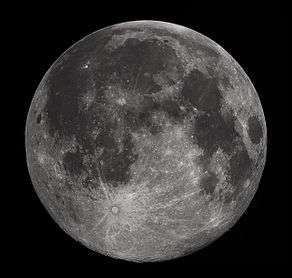Moonlight
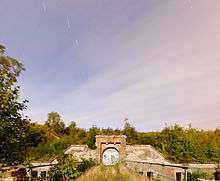
Moonlight is the light that reaches Earth from the Moon, consisting mostly of sunlight, with some starlight and earthlight reflected from those portions of its surface which the Sun's light strikes.[1]
Illumination
The intensity of moonlight varies greatly depending on the lunar cycle but even the full Moon typically provides only about 0.1 lux illumination. When the Moon is viewed at high altitude at tropical latitudes, the illuminance can reach 0.26 lux.[2] The full Moon is about 1,000,000 times fainter than the Sun.
The color of moonlight, particularly near full Moon, appears bluish to the human eye compared to most artificial light sources. This is because of the Purkinje effect - the light is not actually tinted blue, and although moonlight is often referred to as "silvery" it has no inherent silvery quality. The Moon's albedo is 0.136,[3] meaning only 13.6% of sunlight incident on the Moon is reflected. Moonlight generally hampers astronomical viewing, so astronomers usually avoid making observations near full Moon. It takes approximately 1.26 seconds for the moonlight to hit the Earths surface.
 Moonlight over the VLT
Moonlight over the VLT- Moonlight illuminates a lake and surroundings on the Earth
.jpg) Moon colored red by an eclipse
Moon colored red by an eclipse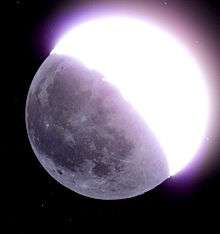 Left side lit by the Earth, other side by the Sun
Left side lit by the Earth, other side by the Sun With the right manipulation, photographs of moonlight don't appear that much different from sunlight.
With the right manipulation, photographs of moonlight don't appear that much different from sunlight.
Folklore
In folklore, moonlight sometimes has a harmful influence. For example, sleeping in the light of a full Moon on certain nights was said to transform a person into a werewolf. The light of the Moon was thought to worsen the symptoms of lunatics, and to sleep in moonlight could make one blind, or mad.[4] Nyctalopia (night blindness caused by a lack of vitamin A) was thought to be caused by sleeping in moonlight in the tropics.
"Moon blindness" is a name for equine recurrent uveitis. It is no longer thought to be caused by moonlight.
In the 16th century, moonmilk, a soft white limestone precipitate found in caves, was thought to be caused by the rays of the moon.[5]
Moonlight in art
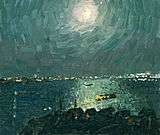 Лунная ночь на Волге - Moonlight Night on the Volga river by Vladimir Ovchinnikov
Лунная ночь на Волге - Moonlight Night on the Volga river by Vladimir Ovchinnikov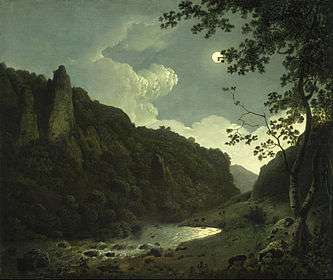
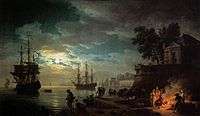 Seaport by Moonlight by Claude Joseph Vernet
Seaport by Moonlight by Claude Joseph Vernet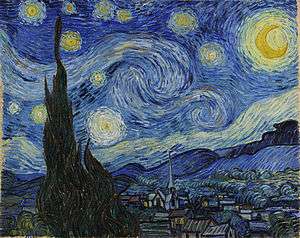
 Clair de lune sur le port de Boulogne - Seaport of Boulogne by Moonlight by Édouard Manet
Clair de lune sur le port de Boulogne - Seaport of Boulogne by Moonlight by Édouard Manet Visitor to a moonlit churchyard by Philip James de Loutherbourg
Visitor to a moonlit churchyard by Philip James de Loutherbourg
See also
References
- ↑ Toomer, G. J. (December 1964). "Review: Ibn al-Haythams Weg zur Physik by Matthias Schramm". Isis. 55 (4): 463–465 [463–4]. doi:10.1086/349914.
- ↑ Bunning, Erwin; Moser, Ilse (April 1969). "INTERFERENCE OF MOONLIGHT WITH THE PHOTOPERIODIC MEASUREMENT OF TIME BY PLANTS, AND THEIR ADAPTIVE REACTION". Proceedings of the National Academy of Sciences of the United States of America. 62 (4): 1018–1022. Bibcode:1969PNAS...62.1018B. doi:10.1073/pnas.62.4.1018. PMC 223607
 . PMID 16591742. Retrieved 2006-11-10.
. PMID 16591742. Retrieved 2006-11-10. - ↑ Matthews, Grant (2008). "Celestial body irradiance determination from an underfilled satellite radiometer: application to albedo and thermal emission measurements of the Moon using CERES". Applied Optics. 47 (27): 4981–93. Bibcode:2008ApOpt..47.4981M. doi:10.1364/AO.47.004981. PMID 18806861.
- ↑ A Dictionary of English folklore, Oxford University Press, 2000
- ↑ Gessner, Conrad (1555). Descriptio Montis Fracti sive Montis Pilati [Description of Mount Fractus, or Mount Pilatus] (in Latin). p. 54. Retrieved March 12, 2016.
External links
| Look up moonlight in Wiktionary, the free dictionary. |
| Wikimedia Commons has media related to Moonlight. |
- Phases of the Moon at USNO
- Strange Moonlight at Science@NASA
- Moonlight Brightness at LunarLight Photography
